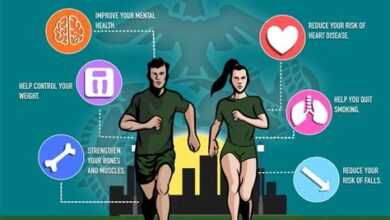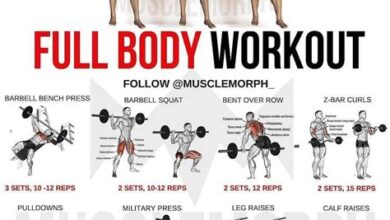How to Set and Achieve Your Fitness Goals

Achieve your fitness goals with our personalized workout plan. Understand your current fitness level, set realistic goals, track progress, and celebrate achievements. Start your journey today!Setting and achieving fitness goals can be a challenging but rewarding journey. Whether you’re aiming to improve your strength, endurance, flexibility, or overall health, having a clear plan in place is essential for success. In this blog post, we will discuss the key steps to help you set and achieve your fitness goals. From understanding your current fitness level to creating a personalized workout plan and tracking your progress, we will provide practical tips and advice to guide you on this journey. We will also explore the importance of setting specific and realistic goals, as well as making necessary adjustments along the way. By following these steps and celebrating your achievements, you can maintain your progress and continue on the path to a healthier, stronger, and more vibrant self. Let’s dive in and discover how you can take control of your fitness journey and achieve the results you desire.
Understanding Your Current Fitness Level
Before embarking on any fitness journey, it’s important to have a clear understanding of your current fitness level. This involves taking an honest assessment of your physical abilities, strengths, weaknesses, and overall health. Understanding where you currently stand will help you set realistic and achievable goals for your fitness journey.
Assessing your current fitness level involves looking at various factors such as cardiovascular endurance, strength, flexibility, and body composition. You may want to consider factors like your resting heart rate, the number of push-ups or squats you can do, how far you can run or walk, and your body fat percentage. Understanding these metrics can give you a clearer picture of your current physical condition.
In addition to physical assessments, it’s also important to consider your lifestyle, including your activity levels, diet, stress levels, and sleep patterns. All of these factors can play a significant role in your overall fitness level. By understanding where you are starting from, you can better tailor your fitness goals and strategies to suit your individual needs and circumstances.
Setting Specific and Realistic Goals
When it comes to setting fitness goals, it’s important to be specific and realistic about what you want to achieve. Instead of saying I want to lose weight, try setting a goal like I want to lose 10 pounds in the next 3 months. This gives you a clear target to work towards, rather than a vague idea. Additionally, it’s crucial to set goals that are achievable within your current lifestyle and abilities. If you’re just starting out, aiming to run a marathon in a month may not be realistic, but setting a goal to run a 5k in 3 months could be much more attainable.
It’s also important to consider the specific actions you need to take in order to reach your goals. For example, if your goal is to improve your strength, you might set a specific target to increase the weight you lift in certain exercises by a certain amount. This level of specificity helps you to create a plan of action and measure your progress along the way. Without specific goals, it’s easy to become demotivated or lose track of what you’re working towards.
Setting realistic goals doesn’t mean you’re limiting yourself – it means you’re being honest about what you can achieve in a given timeframe. It’s important to be realistic about the time, effort, and resources that are required to reach your goals. By setting realistic goals, you set yourself up for success and avoid setting yourself up for disappointment.
Creating a Personalized Workout Plan
Creating a Personalized Workout Plan
When it comes to achieving your fitness goals, having a personalized workout plan is essential. Everyone’s body is different, and what works for one person may not work for another. It’s important to take into consideration your current fitness level, any injuries or limitations you may have, and the specific goals you want to achieve. A personalized plan will help you stay on track and make the most of your workouts.
Before creating your personalized workout plan, it’s important to assess your current fitness level. This can be done through various fitness tests, such as measuring your strength, endurance, flexibility, and cardiovascular fitness. Understanding where you are starting from will help you tailor your workouts to your specific needs and abilities. It’s important to set realistic goals based on this assessment, taking into consideration any limitations or areas that need improvement.
Once you have a clear understanding of your current fitness level and goals, it’s time to create a workout plan that is personalized to you. This plan should include a combination of cardio, strength training, flexibility, and balance exercises. The frequency, intensity, and duration of each workout should be based on your individual needs and goals. It’s also important to incorporate variety into your plan to keep things interesting and to prevent plateaus. Consulting with a fitness professional can be helpful in creating a personalized workout plan that is safe, effective, and enjoyable for you.
Tracking Progress and Making Adjustments
Tracking your progress is an essential part of achieving your fitness goals. It allows you to see how far you’ve come and where you still need to go. By tracking your progress, you can identify any areas that need improvement and make the necessary adjustments to your workout plan.
Making adjustments to your workout plan is crucial for continuing to see results. As your fitness level improves, your body will adapt to your current routine, making it less effective over time. By making adjustments, such as increasing the intensity or adding new exercises, you can keep challenging your body and continue making progress towards your fitness goals.
Remember that making adjustments doesn’t mean completely changing your entire workout plan. Small tweaks here and there can often make a big difference. It’s important to listen to your body and make changes based on what works best for you. By constantly tracking your progress and making adjustments as needed, you can ensure that you stay on track towards achieving your fitness goals.
Celebrating and Maintaining Your Achievements
When it comes to achieving your fitness goals, it’s important to take the time to celebrate your accomplishments. Whether you’ve reached a significant milestone, such as losing a certain amount of weight or running a new personal best, or you’ve simply been consistent with your workouts for a certain period of time, it’s important to acknowledge and celebrate your progress. This can help to boost your motivation and confidence, making it more likely that you’ll continue to work towards and maintain your achievements.
One way to celebrate your fitness achievements is to treat yourself to something special. This could be a new workout outfit, a massage, or a healthy and delicious meal. By rewarding yourself for your hard work, you’re reinforcing positive behavior and giving yourself an extra incentive to keep pushing towards your goals. Additionally, taking the time to recognize and celebrate your achievements can help to build a positive association with your fitness journey, making it more enjoyable and sustainable in the long run.
Once you’ve celebrated your achievements, it’s important to focus on maintaining your progress. This may involve setting new goals to continue challenging yourself, adjusting your workout routine to prevent plateauing, and finding a support system to help you stay accountable. By maintaining your achievements, you’ll be able to enjoy the benefits of your hard work and continue to progress towards a healthier and fitter lifestyle.





